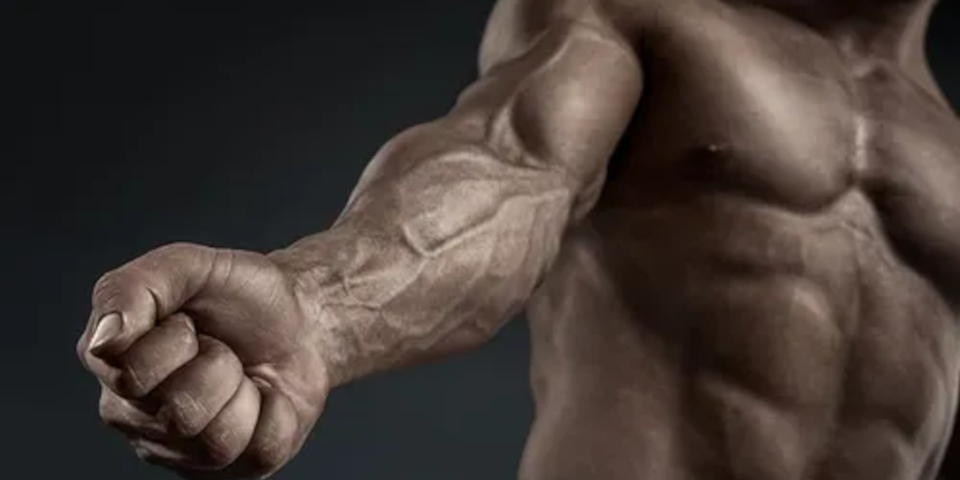
Understanding the Mechanics of Movement: Wrist and Forearm - A Comprehensive Guide
Table of Contents
- Anatomy of the Wrist and Forearm
- Common Issues and Injuries
- Correct Mechanics and Technique
- Exercises and Training Tips
- Real-Life Applications
↗️ 🤝 Share…
Introduction
The mechanics of wrist and forearm movement play a fundamental role in sports training. Understanding how these movements work is not only crucial for improving athletic performance but also for preventing injuries that may arise during physical activity.
Why is it crucial to understand these mechanics?
Understanding wrist and forearm mechanics allows athletes to optimize their performance by executing movements more effectively and precisely. Additionally, knowing the biomechanics of these areas helps identify potential muscular imbalances or weaknesses that could increase the risk of injury.
Summary
In this publication, we will explore in detail the mechanics of wrist and forearm movement, highlighting the muscles involved and their function during different sports activities. We will also discuss effective strategies for strengthening and protecting these areas, as well as the optimal way to exercise them to improve performance and reduce the risk of injury.
1. Anatomy of the Wrist and Forearm
I will provide a superficial analysis of the bone and musculoskeletal structure of the wrist and forearm, as an introduction to the analysis of movement.
1.1. Hand and Wrist
The anatomy of the wrist joint is quite complex, in some cases it could be considered the most complex in the human body. It consists of a large number of bones and joints that give it a wide range of motion in the hand as well as the strength for a firm grip.
The human hand and wrist consist of 27 bones: 8 carpal bones (wrist bones), 5 metacarpal bones (palm bones), and 14 phalanges (bones of the fingers and thumb).
The wrist joint is called the radiocarpal joint, referring to the articular surfaces that are in contact. On one side, the lower edge of the radius and on the other side the upper edge of the bones that make up the first row of carpal bones (a set of short bones that form what we call the “heel of the hand”).

The wrist is also referred to as a condyloid synovial joint. A condyloid synovial joint allows smooth movements between adjacent bones. It is where the joint is more oval in shape, allowing movement along two axes.
This allows for several wide ranges of motion, including flexion (upward), extension (downward), abduction (little finger side of the hand moving away from the body), and adduction (thumb side of the hand moving towards the body). Due to the longer (more distal) ulnar styloid process, abduction is limited. The distal radioulnar joint enables pronation (palm facing down) and supination (palm facing up).
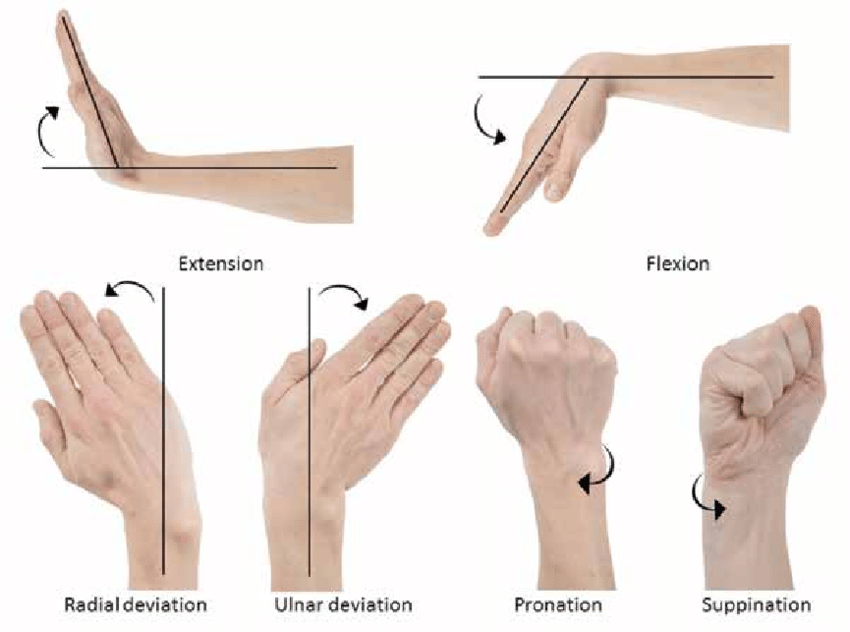
1.2. Forearm
The forearm (antebrachium) consists of the radius and ulna. Proximally, the forearm articulates with the humerus through the elbow complex (humeroulnar and humeroradial joints). Distally, the forearm articulates with the carpal bones through the wrist complex, enabling a wide array of actions. The muscles of the forearm that act upon the elbow, wrist complex, and the digital joints are organized into two fascial compartments, similar to those of the arm muscles. The anterior compartment contains flexor muscles, and the posterior compartment contains extensor muscles.
1.2.1. Anterior Compartment of the Forearm
The muscles in the anterior compartment of the forearm are organized into three layers:
Superficial: pronator teres, flexor carpi radialis, palmaris longus, flexor carpi ulnaris.
Intermediate: flexor digitorum superficialis.
Deep: flexor pollicis longus, flexor digitorum profundus, and pronator quadratus.
This muscle group is associated with pronation of the forearm, flexion of the wrist, and flexion of the fingers.
They are mostly innervated by the median nerve (except for the flexor carpi ulnaris and medial half of the flexor digitorum profundus, which are innervated by the ulnar nerve), and they receive arterial supply from the ulnar artery and radial artery.
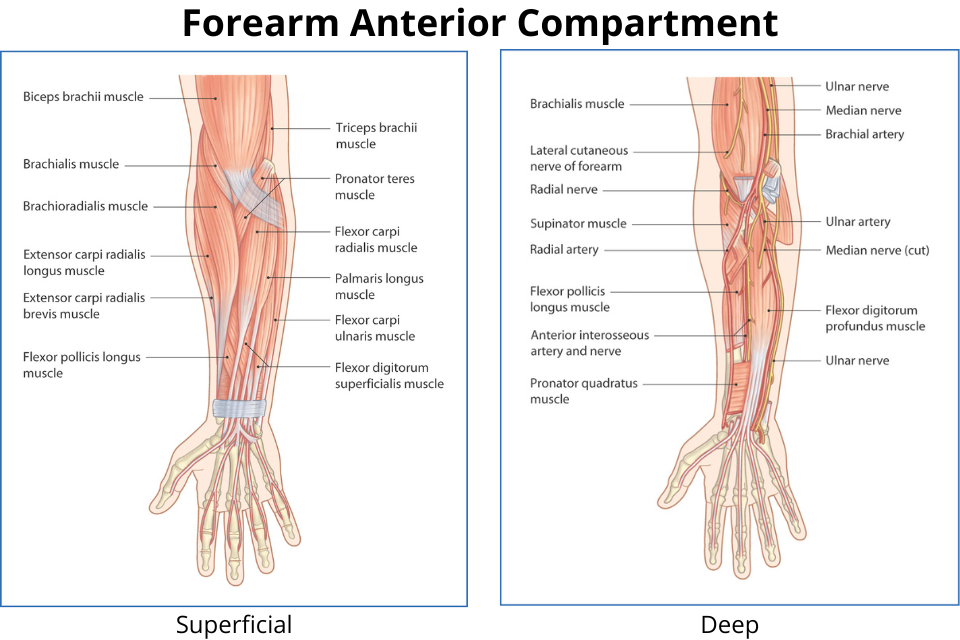
1.2.2. Posterior Compartment of the Forearm
The posterior compartment of the forearm is located between the elbow and wrist joints. It contains 12 muscles divided into superficial and deep groups. These muscles are supported by the radius and ulna. The main function of the forearm muscles (except for the brachioradialis and supinator) is the extension of the wrist and fingers. The brachioradialis flexes the forearm, while the supinator laterally rotates (supinates) it.
The muscles in this compartment are organized into two layers: deep and superficial. These two layers are separated by a layer of fascia.
Superficial Muscles: The superficial layer of the posterior forearm contains seven muscles. The brachioradialis (elbow flexor), Extensor Carpi Radialis Longus and Brevis (ECR, can produce both abduction and extension of the wrist), Extensor Carpi Ulnaris (ECU, adduction and extension of the wrist), Extensor Digitorum, Extensor Digiti Minimi (little finger extensor), Extensor Carpi Ulnaris (ECU) and Anconeus (extends and stabilizes the elbow joint).
Deep Muscles: In the deep layer of the posterior forearm, there are five muscles: the Supinator, the Abductor Pollicis Longus, the Extensor Pollicis Brevis, the Extensor Pollicis Longus, and the Extensor Indicis. With the exception of the supinator, these muscles act on the thumb and index finger.
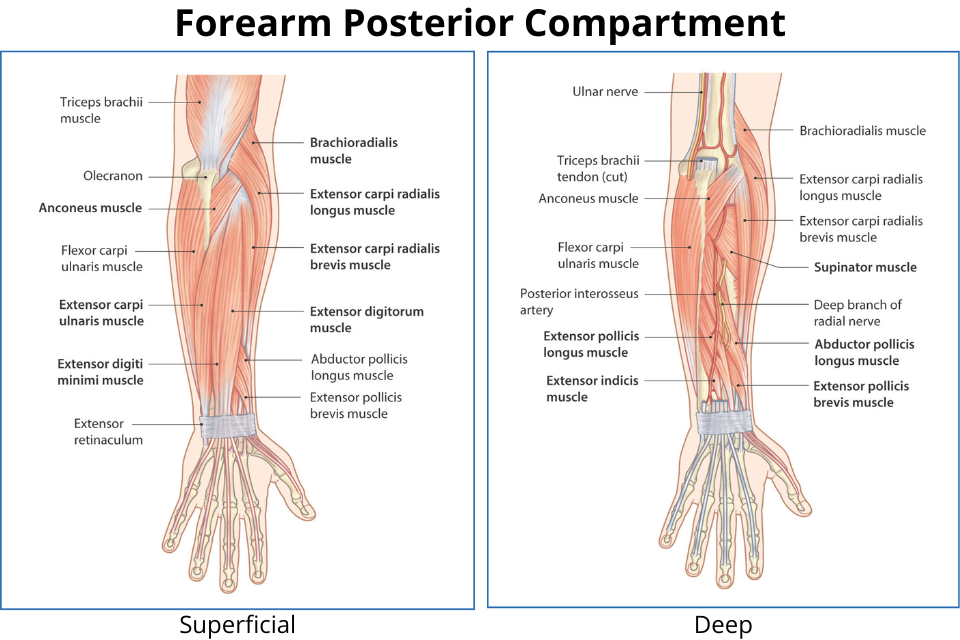
2. Common Issues and Injuries
In today’s world, where daily and work activities often require repetitive use of hands and arms, it’s not surprising that wrist and forearm problems and injuries are common. These conditions can range from mild discomfort to issues requiring medical attention and can significantly affect a person’s quality of life.
2.1. Common Problems and Injuries
Among the most frequent injuries is carpal tunnel syndrome, a condition that arises from pressure on the median nerve, which runs through the carpal tunnel in the wrist. Symptoms include pain, numbness, and weakness in the affected hand. Tendinitis, inflammation of the tendons, is another common condition that causes pain and tenderness near a joint. Sprains, which are injuries to the ligaments, are also common and can vary in severity.
2.2. Causes of Wrist and Forearm Problems
The causes of these problems are usually related to the overuse of these body parts, especially in activities involving repetitive movements or improper postures. Poor technique during physical or sports activities can also contribute to injuries. Additionally, muscular imbalances can lead to an uneven distribution of stress across joints and tissues, increasing the risk of injury.
2.3. Prevention and Management
To prevent these conditions, it is crucial to adopt measures such as performing an adequate warm-up before any intense physical activity. Regular stretching can improve flexibility and reduce tension in muscles and tendons. Moreover, strengthening exercises specific to the wrist and forearm can help create stronger support around the joints. In case of injury, it is essential to seek medical advice and follow the recommended treatment plan.
In summary, while wrist and forearm problems and injuries are common, there are effective steps that can be taken to prevent or manage them. The key lies in prevention through proper practices and self-care.
3. Correct Mechanics and Technique
3.1. Maintaining Proper Wrist and Forearm Mechanics
Maintaining proper wrist and forearm mechanics is essential for effectively and safely performing exercises and activities. Correct alignment and a full range of motion are fundamental to preventing injuries and enhancing performance.
3.1.1. Guidelines for Alignment, Stability, and Range of Motion
- Alignment: Ensure that your wrist is in a neutral position, aligned with your forearm (especially in supports), without bending too far forward (flexion) or backward (extension).
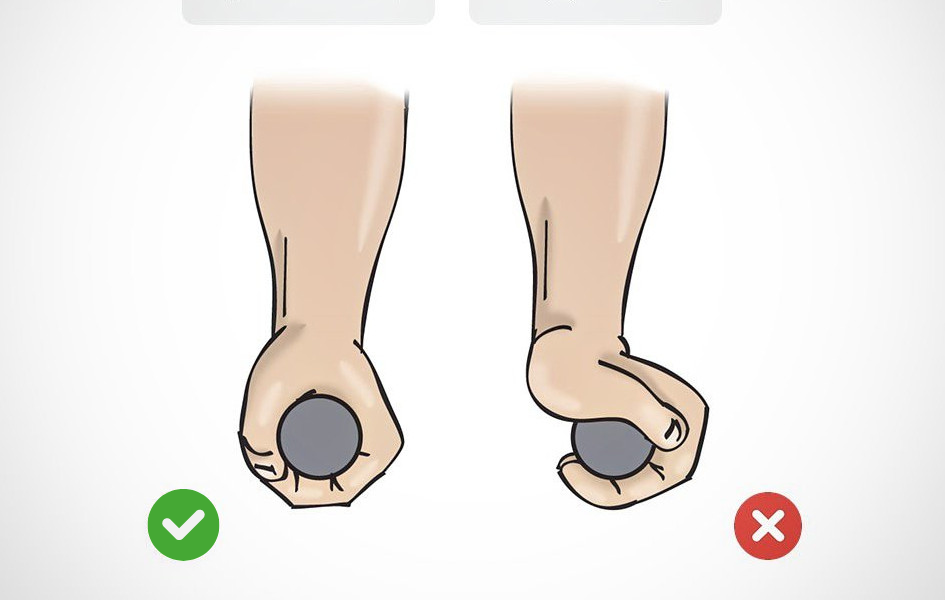
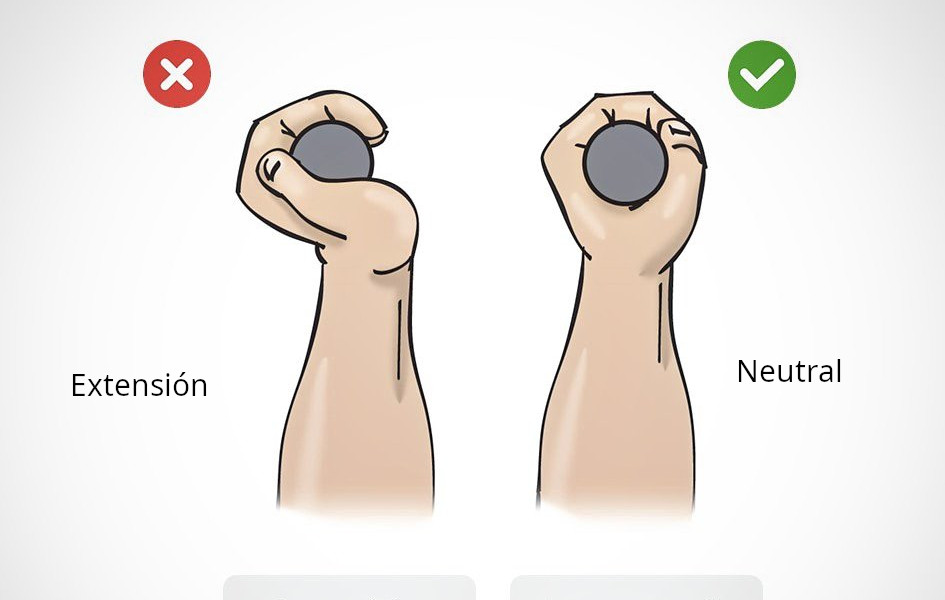
- Stability: Strengthen the muscles of the forearm to improve wrist stability. This can be achieved through specific exercises that focus on these muscle groups.
- Range of Motion: Perform mobility exercises and stretches to maintain a healthy range of motion. This is crucial for activities that require precision and control.
3.1.2. Tips for Improving Grip Strength and Forearm Stability
- Grip Strength: Use exercises like hand grips, weight lifting, and climbing to increase grip strength.
- Forearm Stability: Incorporate exercises that require maintaining the position of the forearm while moving the rest of the body, such as planks or exercises with a medicine ball.
3.2. Proper Warm-Up, Stretching, and Strengthening Exercises
Before any physical activity, it’s important to perform a proper warm-up to prepare the muscles and joints. Stretching should focus on the wrist and forearm to improve flexibility. Strengthening exercises should be progressive, starting with light weight and gradually increasing as strength develops.
By following these guidelines, you can maintain proper wrist and forearm mechanics, which is crucial for the in-depth development of any research or activity involving these body parts.
4. Exercises and Training Tips
Strengthening these already studied muscles and improving their flexibility can enhance sports performance, prevent injuries, and alleviate pain associated with conditions such as carpal tunnel syndrome. We will study the different exercises that can be applied, their variations, and the mechanical-anatomical approach for their correct execution and adaptation to the needs of each person.
4.1. Exercise Selection
4.1.1. Wrist Curls
Objective: Strengthen the flexors.
Execution: Seated, with arms resting on the legs, palms facing up. Hold a barbell with an appropriate weight, with palms facing up. Keep the elbows steady and flex the wrists upwards until the palms face the body. Pause and then slowly lower the wrists back to the starting position. Repeat the movement for 10-15 repetitions.
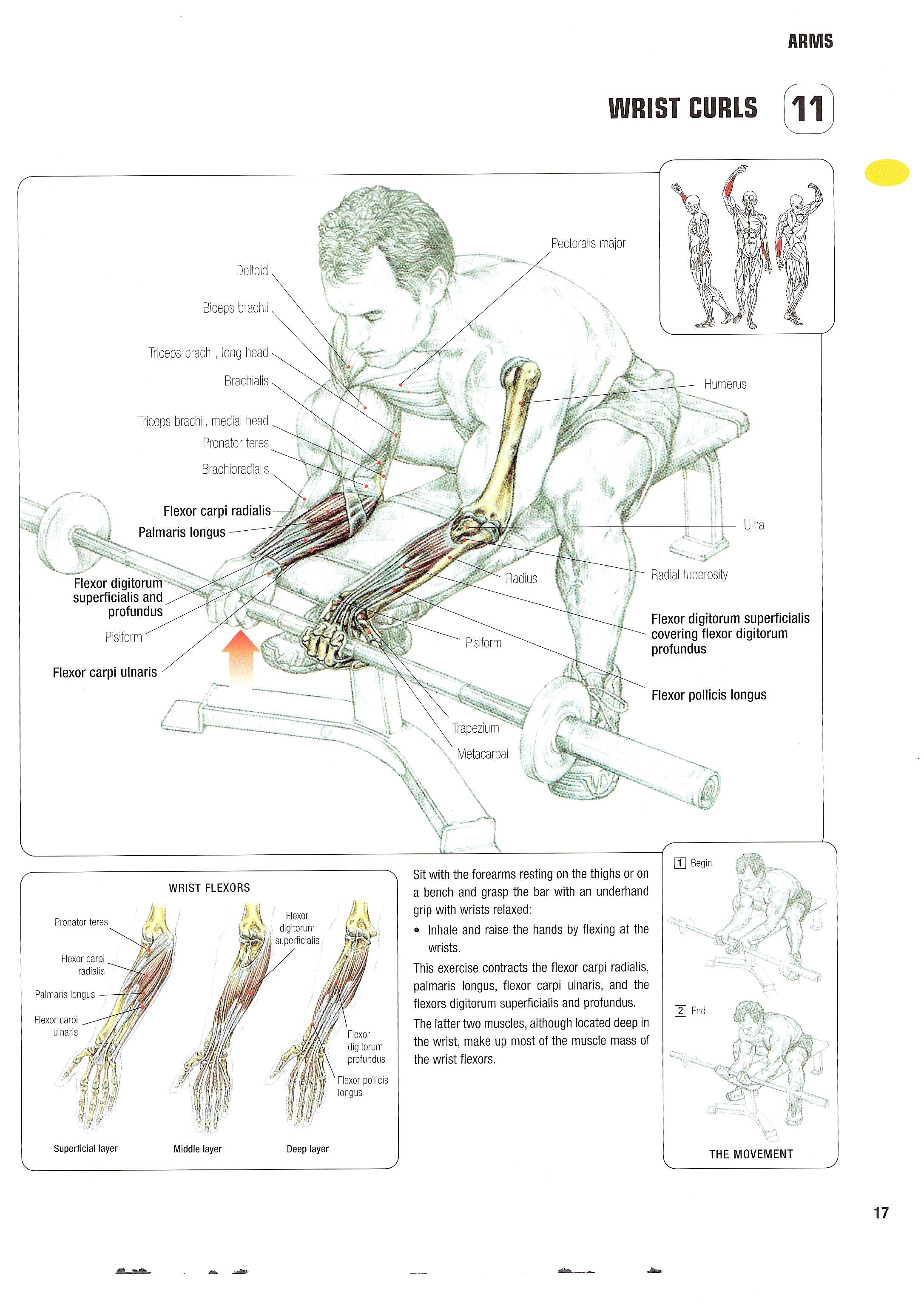
Tips/Variations: Use a straight bar or an EZ bar to change the grip angle. Adjust the weight according to your strength level. You can use a dumbbell in each hand to work unilaterally. You can use a resistance band to vary the intensity, the idea is an appropriate weight to do a complete job in the range of 10 to 15 repetitions. The arm support can be a bench or your thighs. Understanding the mechanics of the movement, it can be done standing (for example, if the tension of the band is horizontal or a bar behind the body) or seated.
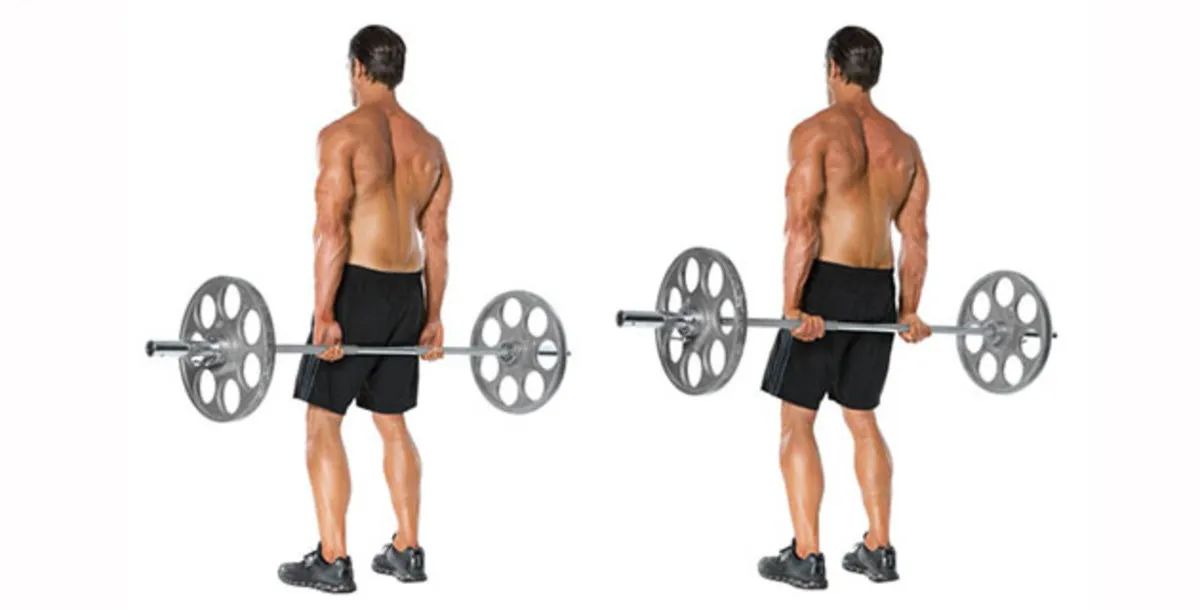
4.1.2. Reverse Wrist Curls
Objective: Strengthen the extensors.
Execution: Sitting, with arms resting on your legs, wrists in flexion. Hold a bar with appropriate weight, palms facing down. Keep your elbows firm and flex your wrists upwards until your knuckles face your body (full extension). Pause and then slowly lower your wrists back to the starting position. Repeat the movement for 10-15 repetitions.

Tips/Variations: Use a straight bar or an EZ bar to change the grip angle. Adjust the weight according to your strength level. You can use a dumbbell in each hand to work unilaterally. You can use a resistance band to vary the intensity, the idea is an appropriate weight to do a complete job in the range of 10 to 15 repetitions. The arm support can be a bench or your thighs. Understanding the mechanics of the movement, it can be done standing.
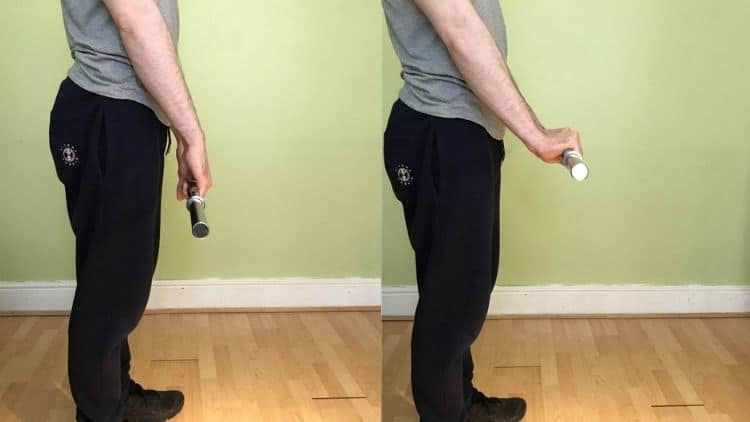
4.1.3 Dumbbell Wrist Curl in Neutral Grip
Objective: Strengthen the flexor and extensor muscles of the wrist with extra emphasis on pronators and supinators.
Execution: Seated, with arms resting on legs, palms facing inward (neutral). Hold a dumbbell in each hand, in adduction. Keep elbows firm and flex wrists upward until you make a complete abduction. Pause and then slowly lower the wrists to the starting position. Repeat the movement for 10-15 repetitions.
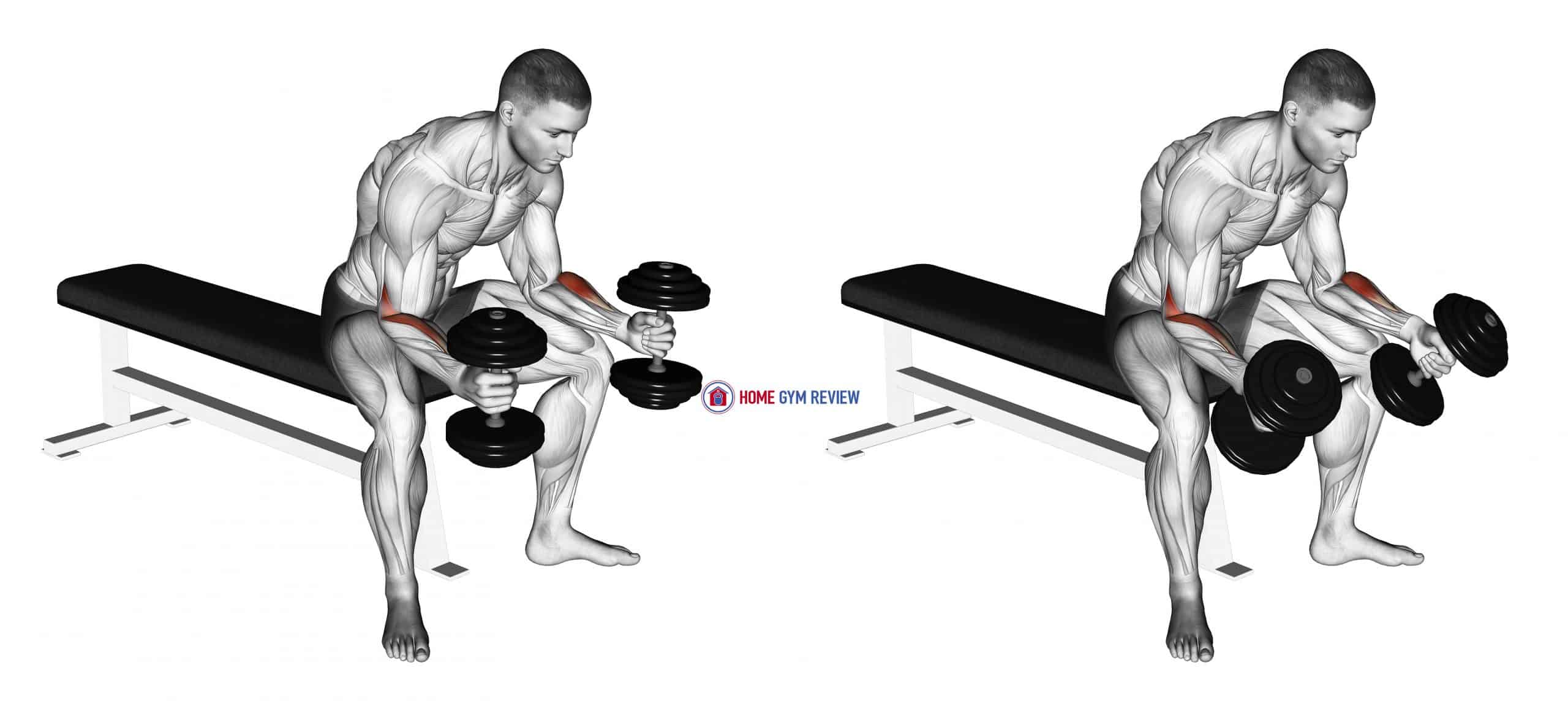
Tips/Variations: Use dumbbells of different weights to increase intensity. You can do the exercise one arm at a time. You can use a resistance band to vary the intensity. You can do it standing with a bar gripped at one end for more wrist intensity.
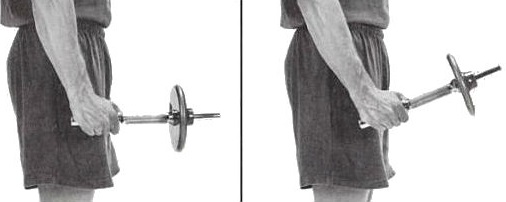
Another important variation is changing the tension towards adduction, this is achieved by shifting the weight backward as seen in the image.
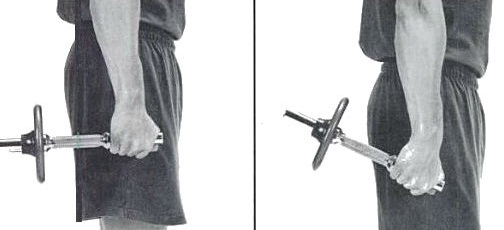
4.1.4. Forearm Pronation/Supination
Objective: Strengthen the pronator and supinator muscles of the forearm.
Execution: The initial form is sitting with one arm supported on a surface, holding a dumbbell and rotating the forearm downwards (pronation) and then upwards (supination). Keep your elbows steady and perform the movement with control. Repeat the movement for 10-15 repetitions.

Tips/Variations: Use a bar held by the end to increase intensity. Perform the exercise one arm at a time. It can be done standing or sitting.

Another variation is to do it with a resistance band or with a pulley, this allows a greater range of motion and variable resistance. Pronation can be isolated from supination by varying the angle of tension. For example, with the arm in pronation, if the tension is from abduction, the work will focus on supination, and vice versa.
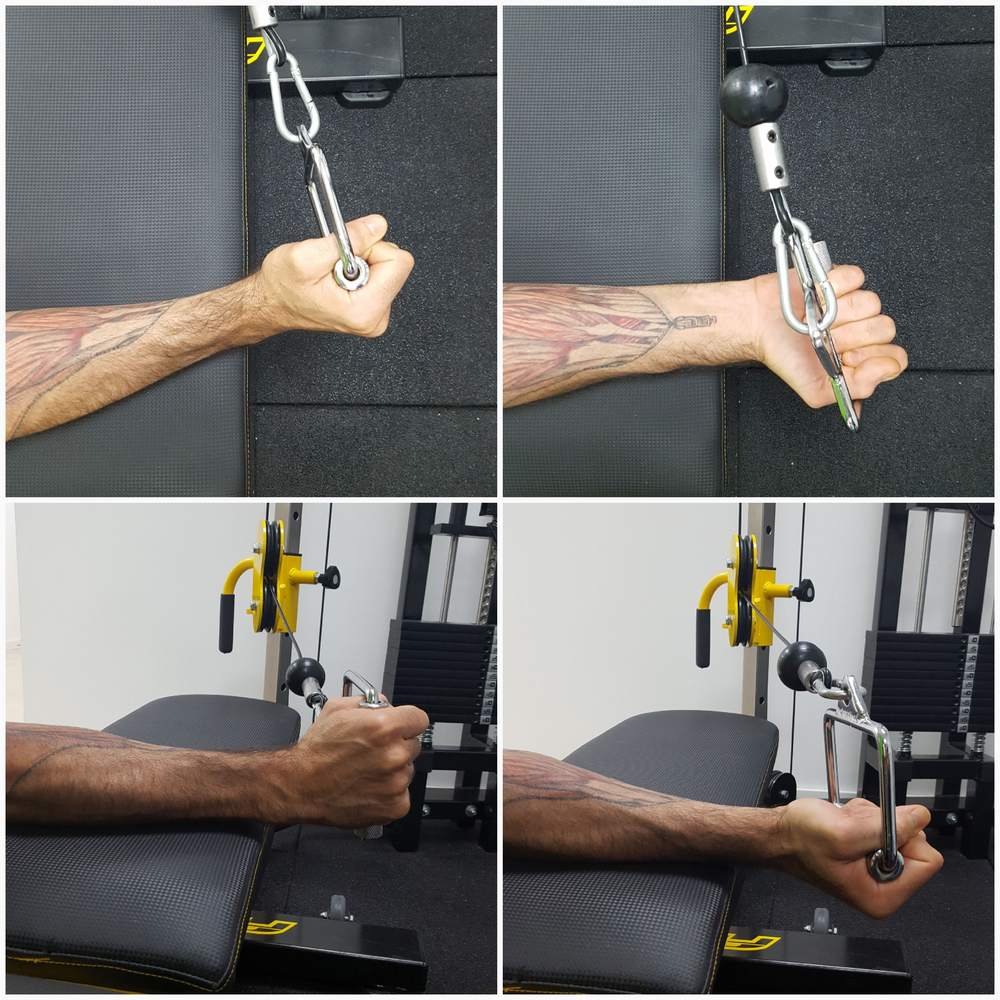
4.1.5. Grip Strength Exercises
Objective: To strengthen the flexor muscles of the fingers and hand.
Execution: Hold a stress ball, grip clip, or dumbbell in your hand. Squeeze the object firmly for a few seconds. Relax your hand and repeat the movement for 10-15 repetitions.
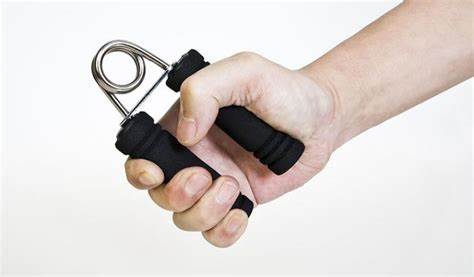
Tips/Variations: Use different objects of different weights. Perform the exercise one hand at a time. Just as the grip is strengthened concentrically, it can also be done eccentrically, that is, resisting the opening of the hand.

There are ways to strengthen the grip isometrically, such as holding a bar or dumbbell for a set period of time.
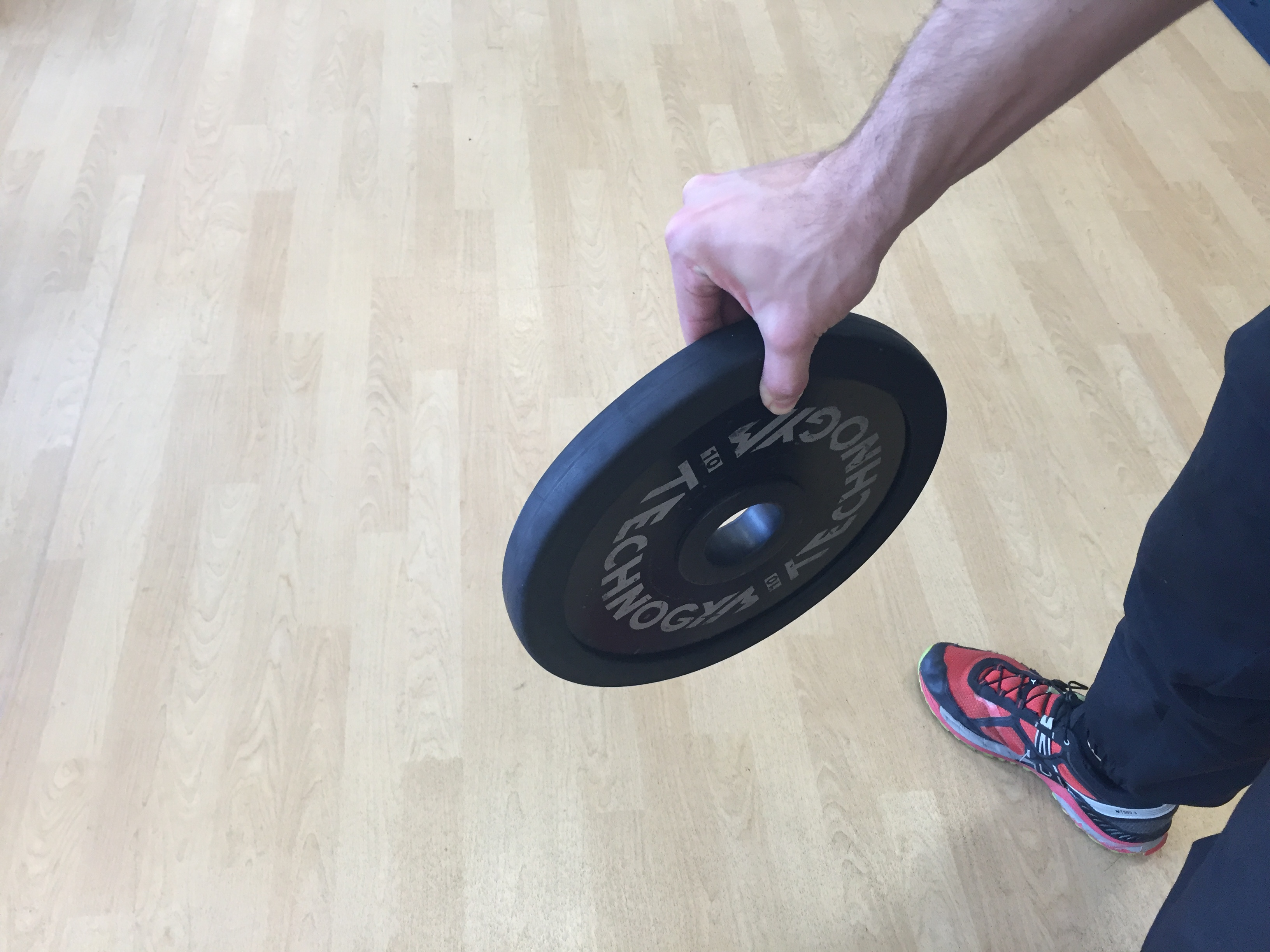
Hanging from a bar, especially in a false grip, is an effective way to strengthen the grip and forearm muscles.
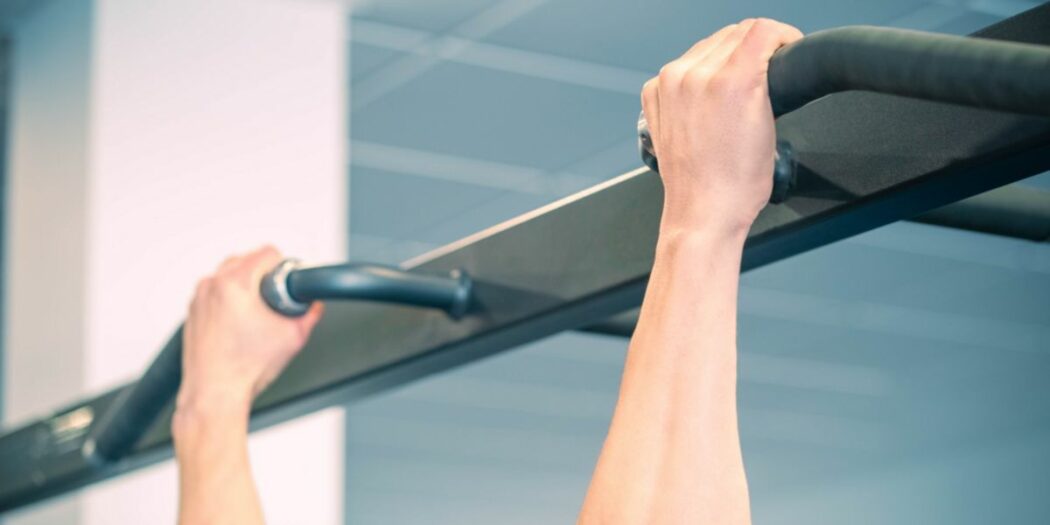
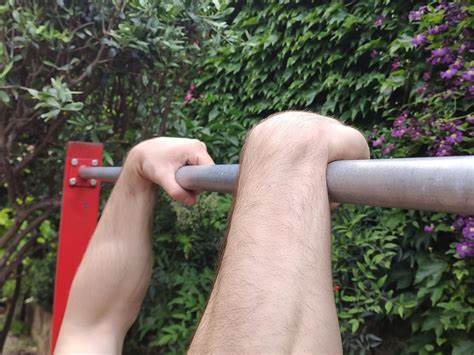
Finally, working on bars or with weight is indeed an effective way to strengthen the grip and forearm muscles. Although it is not the main focus, the relevant muscles and joints are involved.
4.2. Proper Form Instructions
Keep your back straight and core engaged during all exercises. Move with control and avoid jerky movements, take short pauses at the concentric part of the exercise and if possible, extend the execution time of the eccentric part. Do not arch your back or raise your shoulders. If you feel pain, stop the exercise and consult a doctor.
4.2.1. Modifications
If you have pain or discomfort in the wrist, you can perform the exercises with less weight or no weight. If you cannot perform the full range of motion, you can do the exercise with a partial range of motion. You can use a resistance band to assist with the movement. Good practice is to learn and correct the technique without any weight or resistance, and then add weight or resistance.
4.2.2. Tips for Incorporating into a Training Routine[^1^][1]
Start with 2-3 sets of 10-15 repetitions of each exercise. As you get stronger, you can increase the number of sets, repetitions, and/or weight. Perform these exercises 2-3 times a week. It is important to warm up very well before doing any exercise, especially if complex joints or advanced exercises are involved.
4.2.3. Progression Over Time
Increase the number of sets and repetitions. Increase the weight or resistance. Change the routine once you have mastered the basic exercises.
5. Real-World Applications
Understanding the mechanics of the wrist and forearm is essential for optimizing performance in various sports and activities. From weightlifting to rock climbing and racquet sports, the strength, flexibility, and coordination of these structures are key to success.
5.1. Sports Performance Improvement
5.1.1. Weightlifting
Wrist and forearm strength is crucial for a firm grip on the bar, allowing you to lift more weight and perform exercises with greater safety and control. Exercises like dumbbell wrist curls and forearm pronation/supination can strengthen the muscles involved in gripping. It’s important to maintain proper technique during weightlifting to avoid wrist injuries.
5.1.2. Rock Climbing
The wrist and forearm work together to grasp holds, requiring a combination of strength, flexibility, and coordination. Exercises like the “dead hang” and the “campus board” can help improve wrist and forearm strength and endurance. It’s important to warm up well before climbing and perform stretching exercises after the activity.
5.1.3. Racquet Sports
The wrist and forearm are essential for generating power and precision in strokes. Exercises like wrist flexions with resistance bands and grip exercises with a stress ball can strengthen the wrist and forearm muscles. It’s important to perform specific warm-up and stretching exercises for the wrist and forearm before playing.
5.1.4. Day-to-Day
Whether for work or everyday tasks, the wrist and forearm are essential for performing a variety of movements and activities. From lifting weights, handling tools, to household cleaning.
Conclusion
In this post, we have explored the importance of wrist and forearm mechanics in daily life. From anatomy and common injuries to exercises and tips for prevention, we have covered essential information to understand the crucial role of these structures in our performance.
Importance of Wrist and Forearm Mechanics:
The wrist and forearm are responsible for a wide range of movements, from grasping objects to performing sports activities. Strengthening and making these structures more flexible can improve performance in various activities, from manual labor to sports. Preventing injuries to the wrist and forearm is essential to maintain a good quality of life.
Application of Information:
I encourage you to apply the information provided in this blog to your own training. Incorporate wrist and forearm strengthening and flexibility exercises into your routine, and pay attention to proper technique in every activity you perform.
Final Recommendations:
If you need help developing a personalized training plan, consult with a trainer or sports medicine specialist. Remember that the key to success is consistency, patience, and listening to your body.
By prioritizing wrist and forearm mechanics in your training, you can improve your performance in the activities you enjoy most, prevent injuries, and enjoy a more active and healthy life.